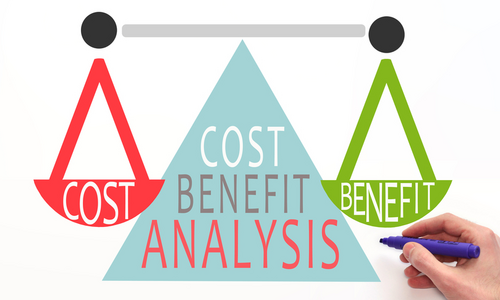Maintaining a balance between controlling project expenses and attaining a higher ROI is a challenge for most project managers. This is when they resort to CBA(Cost-Benefit Analysis). This technique allows them to assess a project’s outcomes in monetary terms. Seasoned professionals always evaluate the risks involved in a project and proceed only if they find proper solutions. The constantly changing economics makes this task quite tedious. To make it easier, project managers use data to analyze cost-related decisions before finalizing them.

Jump ahead to
Define Cost-Benefit Analysis
Cost-Benefit Analysis is a tool for making unbiased project decisions since it throws light on a decision’s economic benefit. Conducting this process may not be a cakewalk at first. Thus, a clear insight into the entire procedure is essential for becoming a pro. To sum up, one needs first to figure out the benefits of a particular business task and add them together. Then they have to compare the associated costs with the total benefits. If the benefits outweigh the costs, they decide to move on with the project or task.
How To Perform Cost-Benefit Analysis?
Listed below are the detailed steps involved in cost-benefit Analysis.
Development
Creating a framework is essential to derive accurate results from a cost-benefit analysis. This calls for determining the organizational goals based on how a company functions and its characteristics. It is the stage for pondering the objectives that an enterprise is planning to achieve.
Another significant task is to decide on a common metric for measuring both benefits and costs of a project. It is better to keep the financial decisions simple to establish the framework. Organizations need to compare their present gains and the profits related to the investment they are about to make. Sometimes it may be right to do nothing and wait, but in the long run, it becomes hard for a business to survive the ongoing market competition.
The cost-benefit analysis framework must contain the following components:
- A time limit for estimating a project’s expected benefits and potential costs
- The category of costs to be used in the Analysis. For instance, opportunity costs may be left out while including the cost of resources and labor
- Application of a certain measurement metric, such as assigning KPIs to intangible benefits and costs
Categorization
This step involves the compilation of two separate lists of the desired gains and the projected expenses of the project. It is important to list the costs under specific heads, which are as follows:
Indirect costs
These refer to the overhead expenses incurred in running a business, such as transportation fees, utilities, or rent. Indirect costs have no direct relation with production. A subscription charge for developing a new mobile application is an example.
Direct costs
Direct costs are the production expenses of a service or commodity. These include labor, equipment, and resource costs. The money spent on developing new software or hiring product testing services is a direct cost.
Risk costs
Expenses associated with possible roadblocks in a project must also be included while compiling the costs list. Risk mitigation procedures aren’t always adequate to entirely avoid the expense of counteracting an unexpected attack. So, one must consider such costs as well.
Intangible costs
These costs cannot be defined, but they emerge eventually during the production or project lifecycle. The introduction of a new service, product, or business process can lead to a decline in a company’s productivity. The expense caused by such a situation is an example of intangible costs. Reduced consumer satisfaction is also another significant event when an organization witnesses such expenditures.
The next step is to identify the benefits of the respective business decision or project. These, too, fall under two categories which are:
Direct benefits
Direct benefits are quantitative gains visible in the form of monetary values, such as increased sales and greater ROI.
Indirect benefits
These benefits are intangible and cannot be measured in terms of money. For instance, improved employee morale and performance or increased brand awareness.
Estimation
Determining the feasible monetary units is the next step in cost-benefit Analysis. Allocating values to every cost and benefit is crucial for accurate comparison and its results. A currency value is suitable for analyzing the direct benefits, risk-related, indirect, and direct costs. On the other hand, KPIs (Key Performance Indicators) are the best means of assessing intangible costs and indirect benefits. For example, consumer churn rate is an effective KPI to measure the decrease or increase in customer satisfaction. Using a common KPI to measure benefits and costs is a smart solution to revise the overall Analysis.
Comparison
There are two approaches to comparing the lists of benefits and costs after allocating monetary values.
NPV
NPV(Net Present Value) is a smart option for cost-benefit Analysis. An NPV value greater than zero indicates the project’s profitability. This method calculates the difference between the present and future cash values in terms of project expenses and benefits. Its results indicate if the anticipated ROI exceeds the present investment in a project.
Benefit-cost ratio
It refers to dividing the total estimated project investment amount by the sum of proposed project costs. If the benefit-cost ratio value exceeds 1, then the project will offer more rewards than the monetary resource it utilizes. This ensures whether a project is worth pursuing or not.
Why Apply Cost-Benefit Analysis?
Cost-benefit Analysis is a screening tool to view a project’s future while deciding which projects to move on with. This method points out the subtle difference in two or more business initiatives that otherwise appear beneficial. After all, money speaks of success, and so does the return on investment in a project. It helps select the best investment option to make the most of limited resources. This process is based on values, making a project more logical and data-driven. It removes the dilemma in making the right business choices.
To obtain a full-fledged knowledge and skill in this methodology, one must undergo professional training. The PMI ACP Certification course would enable aspirants to strengthen their foundation in cost-benefit analysis.



